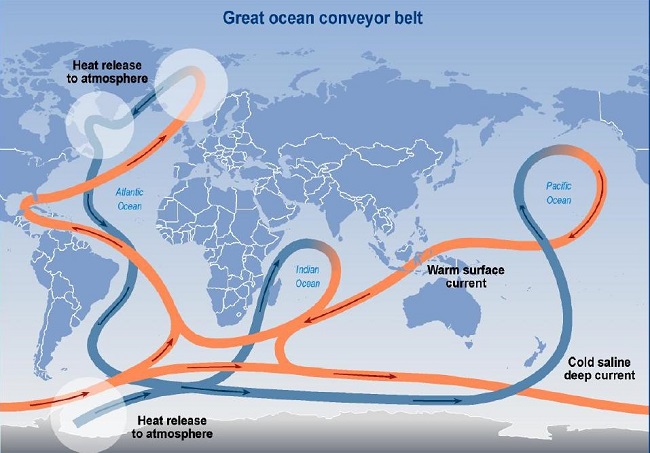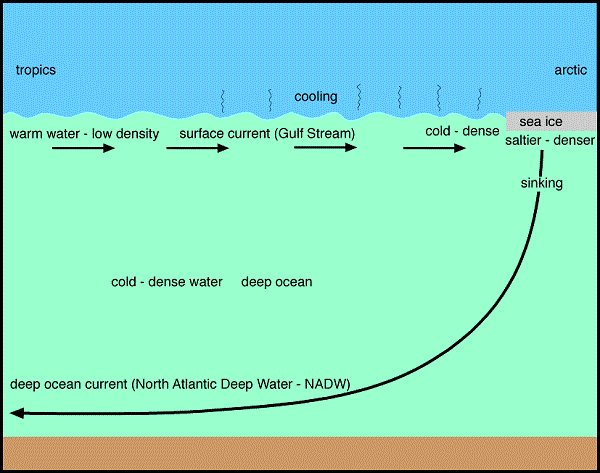Table of Contents
Deep Water Formation
Author: Thomas Singer, Revised by: Aliénor von Roten and Kevin Kilchhofer
Definition
Deep Water is the third part of the ocean, (1. surface layer, 2. boundary layer=thermocline) a layer below the thermocline, where low temperatures and high salinity exist. The pycnocline (meaning rapid change of density) separates the surface layer of the ocean from the deep ocean. Deep ocean water typically has a temperature of about 3°C and the salinity of about 34-35psu. The deep water is about 1500m and more below sea surface. Nearly no light penetrates this area of the ocean. Please refer to Water Masses for definitions of the different types of deep waters.
The Conveyor Belt
The Global Oceanic Conveyor Belt is a system that combines all surface and thermohaline currents and water masses.
The figure above shows the Great Ocean Conveyor Belt with the three specific areas, where the deep water masses are formed.
Processes
Deep water is “formed” where the air temperatures are cold and where the salinity of the surface waters are relatively high. The combinations of high salinity and cold temperatures make the water denser and causes it to sink to the bottom. Unlike the surface circulation (wind-driven), the deep circulation is density-driven. This circulation is very slow (in m/day) and below the pycnocline. Cold, deep water is supplied by deep convection at a few high-latitude locations in the Atlantic, notably in the Labrador Sea and Greenland Sea, both in the North, as well as the Weddell Sea in the South. The Pacific and Northern Indian Ocean have no deep water formation sites.
North Atlantic
In the North Atlantic deep water is formed as warm surface waters from the Southern hemisphere flow north. As mentioned in the paragraph above, surface water cools due to cold, dry winds from northern Canada. These winds also lead to evaporation, which further cools the water. As water molecules escape into the atmosphere, the salinity of the remaining water increases, resulting in higher density. The sinking water, North Atlantic Deep Water (NADW), fills the deep North Atlantic basin, heading South. Deep water formation in The Northern Atlantic is stronger during the winter season. A positive North Atlantic Oscillation (NAO) can reinforce deep water formation, because the stronger wind stress in this atmospheric pattern increases the cyclonic circulation in the Labrador Sea with subsequent upwelling in the center of the Labrador Sea. Additionally, the surface water cools in winter. Under this circumstances, it becomes easier for the surface water to mix down to the deep waters and in the meantime the denser wates are brought further up.
Southern Ocean
In the Southern Ocean deep water formation occurs as water masses below and close to the sea ice cool, due to strong, cold surface winds from the Antarctic continent. These winds are particularly strong during austral (southern hemisphere) winter, thus deep water formation in the Southern Ocean is more distinct then. As the water cools, ice shelf is formed, enriching the water in salt and leading to higher density and therefore sinking to the bottom of the Ocean forming the Antarctic Bottom Water (AABW). In the Weddell Sea, the AABW fills the Atlantic and Indian basin, while the AABW formed in the Ross Sea flows towards the Pacific Ocean.
Why is there no deep water formation in the pacific?
The formation of deep water masses depends on the production of relatively dense surface water, through cooling and/or increase in salinity. Even if the surface waters of the North Pacific were cooled to freezing point, because of their low salinity they would still not be dense enough to sink and initiate deep convection. As consequence, low salinity prevents the North Pacific from deep water formation.
Schematic map showing the deep water formation
There exists also a Interannual variability in formation. The stability of this layering may be destroyed through turbulent mixing caused by wind, combined with an increase in density of the surface waters. In northern polar latitudes, the density of surface water is increased through winter cooling by cold winds and through ice-formation, particularly around the Arctic basin. The Southern Ocean, where the seasonal production of ice is more extensive, the interaction between ice and surface waters plays an even greater role in the formation of dense water. This interaction between ice and surface water is best illustrated through discussion of polynyas (= extensive areas of ice-free water within the winter ice cover). In the Antarctic region, there are two types of polynya, coastal polynyas and open ocean polynyas. Coastal polynyas develop when strong winds blowing off the Antarctic continent, drive newly formed ice away from the shoreline, exposing a zone of open sea that might be 50-100 km wide. Open ocean polynyas develop far from the coast within the pack ice (both over the continental shelf and in deeper water), and include the largest and most long-lived polynyas.
Important deep water masses
The important deep water masses all get their name from the ocean basin they're in.
- NADW - North Atlantic Deep Water
- NPDW - North Pacific Deep Water
- AABW - Antarctic Bottom Water
- IODW - Indian Ocean Deep Water
Other important water masses are
- AAIW - Antarctic Intermediate Water
- SAMW - Subantarctic Mode Water
Information on these water masses can be found in the article on Ocean Water Masses.
References:
- Wikipedia, the free Encyclopedia, online on: http://en.wikipedia.org/wiki/Antarctic_Bottom_Water, last checked: March 26, 2014, 23:00 UTC
- Wikipedia, the free Encyclopedia, online on: http://en.wikipedia.org/wiki/North_Atlantic_Deep_Water, last checked: March 26, 2014, 23:00 UTC
- Wikipedia, the free Encyclopedia, online on: http://en.wikipedia.org/wiki/Antarctic_Intermediate_Water, last checked: March 26, 2014, 23:00 UTC
- Wikipedia, the free Encyclopedia, online on: http://en.wikipedia.org/wiki/Subantarctic_Mode_Water, last checked: March 26, 2014, 23:00 UTC
- Evelyn Brown et. al. 2001, Open Circulation (Second Edition)
- Fröhlicher, Thomas, 2014 Lecture: Introduction to Physical Oceanography at 5.3.2014
- Plattner, Gian-Kasper, 2014 Lecture: Introduction to Physical Oceanography at 12.3.2014
- Plattner, Gian-Kasper, 2014 Lecture: Introduction to Physical Oceanography at 19.3.2014
- Ocean Motion, online on http://oceanmotion.org/html/background/ocean-conveyor-belt.htm, last checked: April 13, 2015
- Wikipedia, the free Encyclopedia, online on: http://en.wikipedia.org/wiki/Thermohaline_circulation#Formation_of_deep_water_masses, last checked: April 13, 2015
- Wikipedia, the free Encyclopedia, online on: http://en.wikipedia.org/wiki/Antarctic_Bottom_Water, last checked: April 13, 2015
- Wikipedia, the free Encyclopedia, online on: http://de.wikipedia.org/wiki/Nordatlantische_Oszillation, last checked: April 13, 2015
- Katherine Richardson et al. 2007, Wie bedroht sind die Ozeane? (Third Edition)
Comments
Please restructure the artcile in the following way: — Samuel Eberenz 2015/03/10 12:30
- take the definitions of the different water mases from this page and merge them into the definitions in the article Ocean Water Masses. Then, put a link to this artcile here. (gemacht)
- restructure this article:
- start with “Conveyer Belt” paragraph, also link to the article The Conveyorbelt
- describe processes of deep water formation in the different sinking regions. Why is it happening there? which time of the year? which preconditioning and processes? which water masses are formed? If you are unsure about this after the lecture, please ask me or the lecturer. (gemacht)
- end with a short list of the deep water masses and link to Ocean Water Masses (gemacht)
- Note that mode and intermediate water masses are not considered a deep water mass (gemacht) — Alexander Haumann 2014/07/01 11:21

